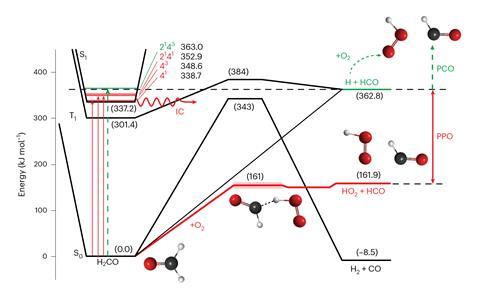A newly discovered pathway for formaldehyde oxidation could be an important general mechanism in tropospheric chemistry. In the new route, absorption of sunlight allows organic molecules to react with atmospheric oxygen in a reaction that had not previously been observed. According to the researchers behind the findings, many compounds in the atmosphere are likely to undergo this process, particularly at low altitudes.
‘We discovered a new way molecules in the atmosphere can react,’ says Scott Kable at the University of New South Wales in Australia. He explains that in this process – called photophysical oxidation (PPO) – a molecule absorbs sunlight and before it breaks into fragments, it reacts with atmospheric oxygen to produce free radicals. In the common photochemical oxidation (PCO) reaction, which has been known for several decades, the molecules are first split by sunlight and then the fragments react with oxygen. ‘Importantly, the free radical fragments formed in the first step of PCO can be measured separately in the atmosphere or a lab,’ points out Kable.
The team demonstrated the PPO mechanism using formaldehyde as a model system. Meredith Jordan from the University of Sydney mentions that many organic compounds released to the environment turn into formaldehyde on their way to being oxidised to carbon dioxide. ‘But most importantly for our research, the spectroscopy and photochemistry of this compound are very well understood,’ she says. ‘Without this detailed pre-existing knowledge, we wouldn’t have been able to find the evidence of PPO.’
Usually, when formaldehyde absorbs sunlight at wavelengths shorter than 330nm it splits into formyl and hydrogen radicals, which then react with oxygen and produce hydroperoxyl radicals (HO2・). In the new PPO reaction, light excites an electron in the molecule without breaking it apart. ‘This electronic excitation energy can then be converted to vibrational energy, which we also call heat,’ explains Kable. ‘Normally, “hot” molecules cool back to room temperature by colliding with other species in the atmosphere, mostly nitrogen. What we discovered is that if the collision partner is oxygen, which makes up about 21% of the atmosphere, the process of collisional cooling can also lead to reaction.’
The researchers irradiated formaldehyde molecules with a laser beam in the presence of oxygen and used IR spectroscopy to analyse the products formed. ‘At laser energies too low to break the C–H bond, where no PCO should take place, we saw PCO-like molecules in the IR spectrum,’ says Kable. But the reactions involved were too fast, so although the team could detect the final products, they couldn’t see the free radical fragments that were being formed.

To solve this problem, they carried out additional cavity ring-down spectroscopy experiments together with Christa Fittschen from the University of Lille in France. ‘This was a highly specialised setup, which was designed to detect the HO2・radical, the intermediate produced in the PPO reaction,’ says Kable. ‘We measured the amount of HO2・as we changed the absorption wavelength and, again, we observed that this species was produced at wavelengths where the C–H bond of formaldehyde shouldn’t break.’
‘Calculations showed us that the energy thresholds for PPO are about half those for PCO,’ adds Jordan. ‘Breaking a C–H bond in formaldehyde requires about twice as much energy as the reaction of hot formaldehyde with oxygen. In other words, although PCO reactions had ceased in our experiments, there was plenty of energy for PPO to occur.’ Using a kinetic model, the team demonstrated that PPO is fast enough to compete with the collisional cooling process. As the reaction rate increases with oxygen pressure, PPO is likely to be more important at lower altitudes.
‘Understanding the pathways by which radicals—especially HOx species—are generated in the atmosphere is critical to our understanding of how pollutants are processed, and the subsequent generation of other molecules such as those that are thought to be involved in aerosol formation,’ comments Rebecca Caravan at Argonne National Laboratory in the US who wasn’t involved in the project. ‘This work really highlights the important link between chemical physics and atmospheric chemistry, and it will be very exciting to learn more about the generality of PPO and its atmospheric implications.’
References
B A Welsh et al, Nat. Chem., 2023 (DOI: 10.1038/s41557-023-01272-4)












No comments yet